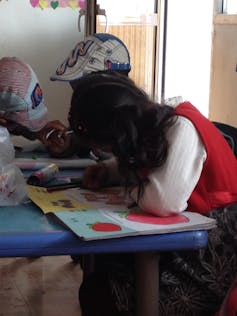How a child’s first language includes more than words
Credit to Author: Ramya Ramanathan| Date: Tue, 03 Mar 2020 23:17:57 +0000
This International Mother Language Day (Feb. 21), Canadians celebrated their multilingual heritage by recognizing flexible uses of languages. According to UNESCO, “Mother tongue or mother language refers to a child’s first language, the language learned in the home from older family members.” As a linguistic anthropologist who studies language use in diverse communities, I know that multilingualism is part of our general human capacity for language.
In a globalized world, many associate multilingualism with mobility and migration. Increasingly, multilingualism appears to be the new norm.
But more than that, linguistic anthropology shows that multilingualism is an essential aspect of how we form belonging and difference. Research on language learning, especially heritage language learning and language revitalization, shows the universality of our capacity for multilingualism.
Multilingualism, globalization and colonialism

Tibetan students study in their mother language (Shannon Ward)
Many Indigenous communities in the Americas practised multilingualism in economic, political and familial activities before European contact. As one of the most densely multilingual regions of the world, the northwest Amazon region is notable in this regard.
Due to restrictions on intermarriage, keeping languages separate helped to uphold the Tukanoan kinship system. With little contact from outside communities, the Tukanoan people used their diverse languages as a resource for building and maintaining kinship bonds.Since the 1970s, anthropologist Jean Jackson has conducted research among the Tukanoan people in the northwest Amazon. Jackson revealed widespread multilingualism in a small-scale society. People marked belonging to their kin groups through more than 16 distinct languages.
The case of the northwest Amazon shows that contact is not essential for multilingualism. In fact, contact arising from settler colonialism has led to widespread language endangerment in the Americas.
Today, the Tukanoan people face language loss alongside colonial domination, climate change and globalization. Negative language attitudes towards Indigenous people who have lost the ability to speak their mother languages have compounded language loss. Amid stigma and changes to kinship structures, efforts to revitalize these diverse languages have proved particularly difficult.
Language recognition as a human right
Recognizing a language is the first step to supporting its speakers. Each International Mother Language Day, we should celebrate marginalized languages and language varieties in addition to major world languages.
In this Tedx Talk, Lindsay Morcom explores why Indigenous languages are matter to linguists and to Indigenous communities.
Language recognition has material consequences for communities. It is associated with increased access to socio-economic stability and mobility. Communities that speak recognized languages receive supports, including representation in language policy, formal education and access to media.
In contrast, some communities speak unrecognized languages. These languages are viewed merely as broken forms of a dominant language rather than as complex codes in their own right. Members of communities who speak unrecognized languages face stigma over their mother languages. Their language capacities are viewed as a hindrance rather than a valuable skill set, and they cannot access resources to support language vitality.
Because language is part of cultural heritage, scholars include language recognition within basic human rights standards. Understanding language rights as human rights links language recognition to freedom of expression and non-discrimination.
Language recognition contributes to community well-being. Even when a language is recognized, however, a lack of acceptance of internal diversity poses considerable challenges to language vitality. When a community values one standard language, flexible ways of speaking may not be celebrated.
Standardization negatively impacts languages and language learners. For example, in the Yukon, linguistic anthropologist Barbra Meek found that an emphasis on elders’ ways of speaking unintentionally excluded children from language revitalization activities. The complexity of learners’ responses to language standardization challenges us to recognize languages without reifying them.
How to foster flexible multilingualism
Canada prides itself on our multilingual heritage. Our government provides funding for multilingual education including the revitalization of Indigenous languages, heritage language learning and second language learning. We can enhance these programs by shifting attention from languages to learners.
My own research with Tibetan families living in urban centres shows that parents encourage children to speak a standard language rather than their regional mother language. Despite the significance of regionally diverse mother languages to adults’ identities, Tibetan communities face pressure to unify heritage language learning around a single standard variety.
In this case, language standardization has prevented Tibetan children from accessing forms of linguistic belonging available to adults. It has also unintentionally contributed to a language shift away from Tibetan mother languages and to dominant languages, including Mandarin and English.
In such situations, immigrant and minority children face two forms of linguistic marginalization. First, a nation’s official languages exclude their recognized heritage language. Second, a standard language spoken within their community excludes their native, mother languages.
These challenges can be overcome with flexible multilingualism which refers to the ongoing validation of diverse language repertoires and acceptance of language change.
Scholars have noted that when children can freely innovate with their language repertoires, they transfer skills and knowledge across languages. When adults validate and celebrate children’s diverse language abilities, they create more productive and engaging learning environments. These abilities include language mixing and innovation.
In short, flexible multilingualism contributes to the vitality of diverse mother languages and brings tangible benefits to language learners.
![]()
UNESCO celebrates the mother languages of people all over the world on International Mother Language Day.
[This article is republished from The Conversation under a Creative Commons license. Read the original article.]